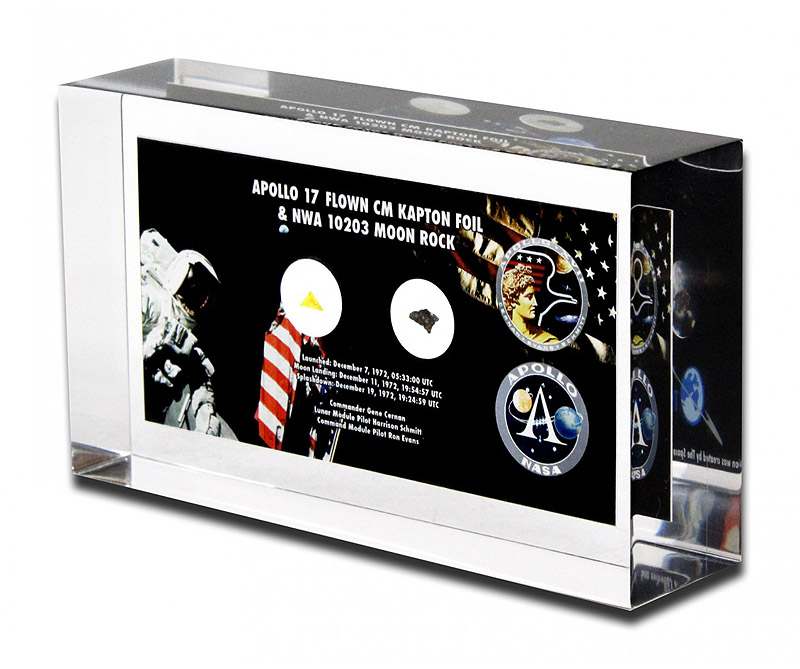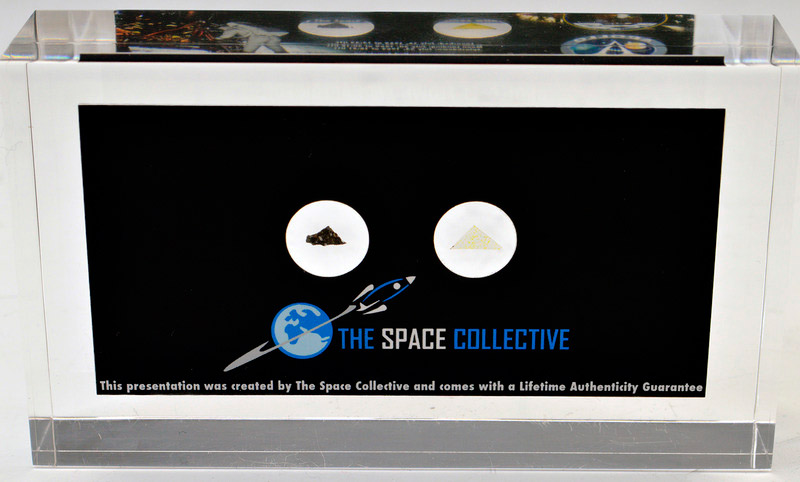Apollo 17 Flown Kapton Foil & Moon Rock Acrylic
Apollo 17 Command Module Flown Kapton Foil & NWA 10203 Moon Rock Lucite.
Encapsulated inside a small (4.75 x 2.75 inch) acrylic
Comes with COA booklet and presentation box
PRICE - $325

Apollo 17 Flown Kapton Foil: The flown material contained within this lucite is Kapton Foil taken from the Apollo 17 Command Module ''America'' after its return to Earth. Kapton Foil, silver-coloured on the front with a gold backing, was attached to the outside skin of the Columbia in order to protect the fragile craft from the extreme environment of deep space. Because the foil was attached to the outside skin of the Columbia, its silver-coloured side was directly exposed to deep space.
NWA 10203 Moon Rock: The moon is constantly hit by meteorites and with no atmosphere and little gravity the larger impacts eject lunar rocks into space. After this impact, this meteorite will eventually be brought down to Earth by the Earth's gravitational pull. Scientists and universities all around the world examine meteorites and compare them with known lunar material, e.g. samples collected during the Apollo missions. The composition of gases and isotopes found is so unique that they can say for sure the material originated from the moon. The encased meteorite was acquired from Meteorite Hunter and Discovery Channel's ''Meteorite Men'' T.V. Star, Steve Arnold.
About Your Lucite:
Overall Acrylic is 12cm x 7cm x 3cm
Encased Kapton Foil is approx. 8mm x 6mm x 6mm
Encased Moon Rock is approx. 50-100mg
Comes in a wonderful black box bearing the Apollo Program Insignia
Comes with an 8 page booklet containing details of Authenticity, Images & Descriptions of Apollo 17
Apollo 17 was the final mission of NASA's Apollo program, the enterprise that landed the first humans on the Moon. Launched at 12:33 am Eastern Standard Time (EST) on December 7, 1972, with a crew made up of Commander Eugene Cernan, Command Module Pilot Ronald Evans, and Lunar Module Pilot Harrison Schmitt, it was the last use of Apollo hardware for its original purpose; after Apollo 17, extra Apollo spacecraft were used in the Skylab and Apollo–Soyuz programs.
Apollo 17 was the first night launch of a U.S. human spaceflight and the final manned launch of a Saturn V rocket. It was a "J-type mission" which included three days on the lunar surface, extended scientific capability, and the third Lunar Roving Vehicle (LRV). While Evans remained in lunar orbit in the Command/Service Module (CSM), Cernan and Schmitt spent just over three days on the moon in the Taurus–Littrow valley and completed three moonwalks, taking lunar samples and deploying scientific instruments. Evans took scientific measurements and photographs from orbit using a Scientific Instruments Module mounted in the Service Module.
The landing site was chosen with the primary objectives of Apollo 17 in mind: to sample lunar highland material older than the impact that formed Mare Imbrium, and investigate the possibility of relatively new volcanic activity in the same area. Cernan, Evans and Schmitt returned to Earth on December 19 after a 12-day mission.
Apollo 17 is the most recent manned Moon landing and was the last time humans travelled beyond low Earth orbit. It was also the first mission to be commanded by a person with no background as a test pilot, and the first to have no one on board who had been a test pilot; X-15 test pilot Joe Engle lost the lunar module pilot assignment to Schmitt, a scientist. The mission broke several records: the longest moon landing, longest total extravehicular activities (moonwalks), largest lunar sample, and longest time in lunar orbit.
Please note these acrylics are smaller than our Apollo 12 and Apollo 16 Moonpans Acrylics
NWA 10203 Moon Rock: The moon is constantly hit by meteorites and with no atmosphere and little gravity the larger impacts eject lunar rocks into space. After this impact, this meteorite will eventually be brought down to Earth by the Earth's gravitational pull. Scientists and universities all around the world examine meteorites and compare them with known lunar material, e.g. samples collected during the Apollo missions. The composition of gases and isotopes found is so unique that they can say for sure the material originated from the moon. The encased meteorite was acquired from Meteorite Hunter and Discovery Channel's ''Meteorite Men'' T.V. Star, Steve Arnold.
About Your Lucite:
Comes with an 8 page booklet containing details of Authenticity, Images & Descriptions of Apollo 17
Apollo 17 was the final mission of NASA's Apollo program, the enterprise that landed the first humans on the Moon. Launched at 12:33 am Eastern Standard Time (EST) on December 7, 1972, with a crew made up of Commander Eugene Cernan, Command Module Pilot Ronald Evans, and Lunar Module Pilot Harrison Schmitt, it was the last use of Apollo hardware for its original purpose; after Apollo 17, extra Apollo spacecraft were used in the Skylab and Apollo–Soyuz programs.
Apollo 17 was the first night launch of a U.S. human spaceflight and the final manned launch of a Saturn V rocket. It was a "J-type mission" which included three days on the lunar surface, extended scientific capability, and the third Lunar Roving Vehicle (LRV). While Evans remained in lunar orbit in the Command/Service Module (CSM), Cernan and Schmitt spent just over three days on the moon in the Taurus–Littrow valley and completed three moonwalks, taking lunar samples and deploying scientific instruments. Evans took scientific measurements and photographs from orbit using a Scientific Instruments Module mounted in the Service Module.
The landing site was chosen with the primary objectives of Apollo 17 in mind: to sample lunar highland material older than the impact that formed Mare Imbrium, and investigate the possibility of relatively new volcanic activity in the same area. Cernan, Evans and Schmitt returned to Earth on December 19 after a 12-day mission.
Apollo 17 is the most recent manned Moon landing and was the last time humans travelled beyond low Earth orbit. It was also the first mission to be commanded by a person with no background as a test pilot, and the first to have no one on board who had been a test pilot; X-15 test pilot Joe Engle lost the lunar module pilot assignment to Schmitt, a scientist. The mission broke several records: the longest moon landing, longest total extravehicular activities (moonwalks), largest lunar sample, and longest time in lunar orbit.
Please note these acrylics are smaller than our Apollo 12 and Apollo 16 Moonpans Acrylics
Rear Side

If you have any questions email us
To be notified of future items like this one Join Our Mailing List
Contact Us
All design and images © moonpans.com

